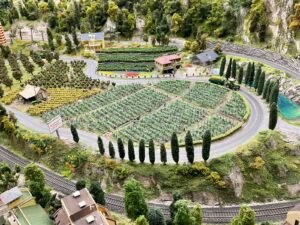How to… create a green active travel route in a city
 From a ‘game-changer’ in east Belfast to a parkland commuter trail in Edinburgh, green active travel routes are changing our cities for the better. A new set of case studies published by the Central Scotland Green Network shows how it’s done, as Angus Gibson explains
From a ‘game-changer’ in east Belfast to a parkland commuter trail in Edinburgh, green active travel routes are changing our cities for the better. A new set of case studies published by the Central Scotland Green Network shows how it’s done, as Angus Gibson explains
The new case studies cover routes in Belfast and Edinburgh as well as cities abroad and highlight how green infrastructure and active travel combine within different contexts to provide benefits for both people and the environment.
By combining natural planting, greenery or water systems together with paths for people on foot or on bike, green active travel routes provide communities with multiple benefits. These include flood mitigation, climate change adaption, increased biodiversity, connectivity and a positive impact on mental health and wellbeing.
Such routes can be created by either adding new travel routes to existing infrastructure or by adding new green infrastructure to existing travel routes – or by integrating both from the start.
‘From the outset the concept of the greenway
was a game-changer for east Belfast and beyond’
A game-changer for east Belfast and beyond
Connswater Community Greenway in east Belfast provides an example of how new green active travel routes can transform both the environment and the local community.
Opened in April 2017, the Connswater Community Greenway has become a living landmark for east Belfast, and a lifeline for biodiversity. The new route joins Belfast Lough to the Castlereagh Hills with a 9km wildlife corridor along the course of the Knock, Loop and Connswater rivers.
The Greenway includes 16km of foot and cycle paths, improved green spaces, 26 new or improved bridges, 5km of floodwalls and embankments, six new tourism and heritage trails, and a public square named after local-born C.S Lewis.
The project highlights the importance of partnership working to deliver green active travel routes. EastSide Partnership and Belfast City council developed the project together in order to best improve the quality of life for local people and create a living legacy for future generation.
Big Lottery Fund, Belfast City Council, the Department for Communities and the Dfl Rivers Agency made the new green active travel route possible through £40m of funding.
The Department of Infrastructure’s River Agency was also a key partner in the project – the Greenway aims to deliver elements of the East Belfast Flood Alleviation Scheme and reduce flooding along the route.
In contrast to the area’s historic reputation, the Connswater Community Greenway has helped to create a greener, cleaner east Belfast with infrastructure that provides benefits to both local communities and international tourists.
‘Think big and plan early, be bold in terms of
ambition and think on a citywide scale’
Sean Brannigan, from the Belfast Regeneration Directorate said: ‘From the outset the concept of the greenway was a game-changer for east Belfast and beyond. The greenway has brought communities together, linking the people of east Belfast to its places.’
Partnership working in Edinburgh
Green active travel routes are also transforming lives and communities in Scotland. Little France Park is key piece of new green infrastructure near Edinburgh’s burgeoning BioQuarter and Royal Infirmary in the south east of the city.
The park was previously undeveloped low-quality arable land, providing a unique opportunity to design and implement a high quality path and cycle network from scratch.
Edinburgh & Lothians Greenspace Trust (ELGT) has managed the progression of the Little France Park project from unused land to valued greenspace. ELGT have succeeded in bringing a variety of local partners and stakeholders together to facilitate the design and master planning of the park – including the green active travel routes.
This successful partnership working enabled funding to be secured from Sustrans, the EDI Group and City of Edinburgh Council, totalling £600,000.
The initial elements of these paths were completed in early 2016, including high quality cycling and walking paths, as well as three distinct parkland areas.
When fully realised, the walking and cycling paths in the parkland will prioritise utility journeys for commuters, patients at the nearby Royal infirmary and local residents – providing more direct and convenient connections that would otherwise be possible by car or public transport.
Little France Park will also form an important part of the regional green network, providing opportunities for outdoor recreation, facilitating further social and health benefits for nearby residents. The parkland also aims to provide improved habitat quality and increased diversity of wildlife.
Ross Woodside, Project Manager for implementation and delivery at ELGT, said: ‘Deliberately integrating green infrastructure and active travel from the start ensures that the multiple benefits of both are lined.’
‘This includes improved health and well-being, increased environmental and aesthetic quality, and improvements in quality of place.’
Little France Park, Connswater Community Greenway and the other projects included in CSGN’s case studies provide inspirations and key learning points that others across the UK can follow.
The common themes that emerge emphasise the importance of partnership working and engaging with local communities. The example case studies teach us to think big and plan early, to be bold in terms of ambition and to think on a citywide scale.
- The full suite of Green Active Travel Routes case studies is available to download from centralscotlandgreennetwork.org/greenactivetravel















